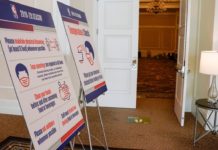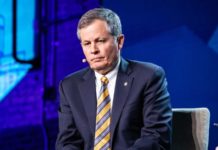ABU DIS, West Bank — Like a monument to dashed hopes, an unfinished Palestinian parliament building stands derelict on a ridge in Abu Dis, an unimposing West Bank suburb of Jerusalem that the Trump administration has proposed as the capital of a future Palestinian state.
A symbol of the possibilities of sovereignty when it was begun in the mid-1990s, the parliament was supposed to have a clear line of sight to the glimmering domes of the revered Al Aqsa Mosque compound in Jerusalem’s Old City, barely two-and-a-half miles away as the crow flies.
Today it backs onto a hulking, razor wire-topped concrete wall, a section of Israel’s security barrier that went up in 2005, isolating wingless creatures in Abu Dis from Jerusalem and its holy sites.
Days after the rollout of the long-awaited Trump plan for resolving the Israeli-Palestinian conflict, which strongly favored Israel and disregarded most Palestinian claims, there was little sense of gathering majesty or of Palestinian control here in Abu Dis.
American administrations have tried repeatedly over decades to mediate a peace agreement between Israel and the Palestinians on far more evenhanded terms than the new proposal. But nothing epitomizes the asymmetry more than how it addresses a Palestinian capital.
Palestinians have long aspired to an independent state with East Jerusalem as its capital, but the proposal does away with the long-held notion that the two sides would negotiate Jerusalem’s future.
Instead, it gives all the desirable parts of the city to Israel and proposes a group of obscure, outlying areas as the closest thing to a capital in Jerusalem that the Palestinians should ever get. It offers Palestinians the tiny, crowded Abu Dis, along with troubled faraway neighborhoods technically in East Jerusalem, but also on the other side of the security barrier.
One of the neighborhoods designated for the capital, the Shuafat refugee camp, is a gang-ridden slum where the Palestinian police have no jurisdiction and the Israeli police fear to tread. Another, Kufr Aqab, became a Wild West of unregulated and unsafe construction when Israeli policies and sky-high housing prices drove middle-class Arabs to seek homes beyond the security barrier but still inside the Jerusalem municipality.
And then there is Abu Dis, the hilly home of Al-Quds University, which opened in the 1980s when the village was just a 10-minute drive from Damascus Gate — one of the portals leading into Jerusalem’s Old City. Most of Abu Dis was never inside the Jerusalem city limits.
“How can this be a capital?” asked Ahmed Bader, 25, incredulously. He had come in a small truck to collect garbage from a patch of wasteland behind the parliament building. Children rode horses bareback in an adjacent alley.
“Jerusalem has the Aqsa mosque, the churches, business, places to work,” he continued. “What do we have here, in our little town? If I stop my little Vespa in the main street to speak on the phone, cars pile up behind and can’t get past me!”
When the Palestinians say they want Jerusalem as their capital, they do not mean areas like Abu Dis, Shuafat or Kufr Aqab.
Shuafat and Kufr Aqab are part of territory that the Israelis annexed to Jerusalem in 1967, in the heady days after their victory in the Six-Day War.
“Jerusalem is the old walled city. The rest is not Jerusalem,” said Nazmi Jubeh, an archaeologist and historian who runs the Birzeit University Museum in the West Bank. “We mean by Jerusalem — and I think everybody around the world means — the holy sites. This game of playing with words has no meaning at all.”
In broad terms, the Trump administration plan would give Israel overall military control from the Jordan River to the Mediterranean Sea. It would allow Israel to annex about 30 percent of the West Bank along with all the Jewish settlements in the territory, though most of the world considers those settlements a violation of international law.
While Israel had long been expected to hold on to some large settlement blocs in the West Bank in return for land swaps, there was also an expectation it would dismantle more isolated settlements in territory designated for a Palestinian state. And rather than Israel annexing the strategic Jordan Valley in its entirety, previous peace proposals envisaged a special security arrangement, possibly involving third party forces, along the border with Jordan.
In return for the concessions to Israel, the Trump plan makes the Palestinians a heavily conditional offer that stands little chance of being accepted: an entity that they could call a state made up of the Gaza Strip and several enclaves in the West Bank — pockmarked with settlements and surrounded by Israeli territory — that would be linked by roads or other transportation.
While Israel hailed the plan, the Palestinians angrily rejected it out of hand.
In myriad ways, the Trump plan seemed to reward the Israelis and punish the Palestinians for what each has considered the other’s bad behavior.
The Israelis relentlessly created facts on the ground, like settlements in the heart of the West Bank aimed at preventing a Palestinian state from coming together. The Palestinians repeatedly resorted to violence, even after Israeli withdrawals, which led Israel to expand its security presence at the Palestinians’ expense and to insist on never uprooting its people again.
In its conceptual map of a Palestinian state, the Trump plan did not even mark the location of a capital, though the document did suggest calling it Al-Quds, the Arabic name for Jerusalem.
It did mark Jerusalem — in Israeli territory.
The Americans determined that Israel should remain sovereign over all parts of Jerusalem, including the ancient holy sites that are inside the security barrier built in the early 2000s after a spate of Palestinian suicide bombings.
At least 120,000 Palestinians live beyond the barrier but still inside the Jerusalem city limits so they can cling to their Jerusalem residency cards, which allow them to work and travel inside Israel. Under the American plan, they would find themselves living in Palestine.
(Inside the barrier, the plan says, the approximately 200,000 Palestinians would get the choice of becoming citizens of Palestine or of Israel, or of maintaining the in-between residency status that most of them have today.)
As a purely geographical matter, the Palestinian capital would be fragmented across several neighborhoods that are miles apart from each other, separated by Israeli communities and major roads, and share little in common. It is not unlike cobbling together a new city from parts of Teaneck, N.J., Queens, and the South Bronx.
The Trump plan promises to manage the feat with new roads, tunnels or bridges.
“If you know these areas, you know they’re just making a joke of you and your national aspiration,” said Mr. Jubeh. “A capital is a symbol,” he added. “These areas are not a symbol for anybody.”
Indeed, the Palestinians are denied even a symbolic toehold in or near the ancient heart of the city. But Israel gets rid of its only refugee camp, and of the violent outland it has become.
In carving off Shuafat, the Trump plan completes what the Israelis first tried to do when they built the security barrier, said Danny Seidemann, an expert on the geography and political history of Jerusalem who is a harsh critic of the Trump plan. It would correct what he said was a mistake in hastily drawing the city boundaries in 1967.
The refugee camp had been a hot spot of violence for years, he said. So the decision was made to build the security wall inside the city “in order to cut them out,” Mr. Seidemann said.
In the Shuafat camp on Thursday, residents laughed at the idea of making their neighborhood a Palestinian showpiece. Water and sewer services in the camp are unreliable at best; the streets contain potholes big enough to lose much of a car.
“It’s a ghost city, not a capital,” said Muhammad Inbawi, 30. “It’s chaos here. At night, we’re ruled by the gangsters. What kind of capital is that? Is Trump sane?”
The place is not so safe by day, either: As Mr. Inbawi spoke, a fog was billowing down the street. It was tear gas fired by Israeli security forces. Crowds of children in school uniforms broke into a run to get away.
Seeing a girl struggling to withstand the effects of the acrid cloud, Mr. Inbawi shouted at no one in particular, “You don’t throw stones when school is letting out!”
Abu Dis, which started out as a sleepy village, now has about 13,000 residents in less than two square miles. It consists of a single main street and higgledy-piggledy alleys shooting off at strange angles.
“We love it,” said Safia, 35, an English teacher who would only provide her first name for fear of repercussions from the authorities. But she added, “Like all Palestinians, I refuse what we call the American-Israeli agreement to take Jerusalem.”
She last visited Jerusalem three years ago to pray during the Muslim holy month of Ramadan, a visit that required a special permit from the Israeli authorities.
Tareq Bader, 22, who works in a car accessory store, was last in Jerusalem about 10 years ago. “It’s so close,” he said, “but difficult to get to.”
But he hasn’t lost faith.
“Trump promised Jerusalem to the Jews,” he said. “God promised it to us, and God is greater than Trump.”
Mohammed Najib contributed reporting.
Source : Nytimes











